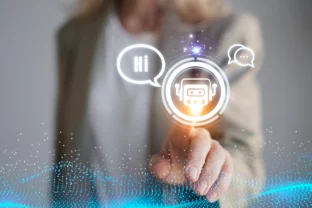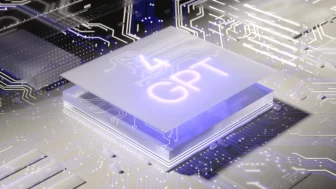
AI-powered HR chatbot for better employee engagement and business growth: Solutions to consider
Summarize:
In their recent guide, Gartner highlights growing interest among HR leaders in exploring generative artificial intelligence (GenAI) — a form of AI capable of creating new content like text, images, and audio. And rightfully so, as this technology is already transforming internal processes. For example, Stanford and MIT researchers found a generative AI-based conversational assistant to positively impact employee experience, learning, and retention in real-world scenarios.
Indeed, AI-powered conversational assistants, or chatbots, offer a cost-efficient way to implement generative AI. Used for key HR needs, chatbots bring major benefits including:
- Automation of routine high-volume HR operations and service delivery
- Personalized employee learning and development
- Facilitated employee lifecycle
- Stronger employer brand reputation


Discover how to drive business value with AI and avoid expensive missteps
Explore our white paperRead on as we explore how businesses can achieve these benefits as well as highlight:
- the challenges your company can solve with an HR chatbot
- five effective use cases illustrated with real-life examples
- ways for you to start leveraging AI-powered solutions
First, let’s understand the basics of AI-powered HR chatbots to better assess use cases and benefits of AI.
AI-powered HR chatbots: Quick look at the specifics
Among various solutions of chatbots for employees, advanced generative AI-powered tools like ChatGPT stand out for delivering personalized responses and serving as easily accessible information hubs.
Generative AI use cases, benefits, and real-life examples
Read the articleWhat exactly is an AI-powered chatbot and what is it capable of?
An AI-powered HR bot, also called a virtual assistant, is a software app that uses artificial intelligence to mimic human conversation. It allows employees and HR staff to ask questions or make requests and get automated, personalized responses.
Key capabilities of AI-powered chatbot for HR services include:
- Understanding natural language questions and requests
- Accessing HR databases and other internal systems to find answers
- Continuously learning from user interactions to enhance accuracy of provided information
- Providing 24/7 support for efficiently handling routine HR inquiries
- Providing personalized guidance based on employee profiles and histories
- Offering analytics and data-driven insights into employee engagement
Partnering with AI development services can further enhance these functionalities, ensuring that HR chatbots are optimized for seamless integration and performance. Let’s explore where these capabilities stem from.
How do HR chatbots work?
AI-powered HR bots use natural language processing (NLP) and machine learning (ML) techniques alongside database integrations and contextual details. This combination enables them to provide accurate, personalized responses to end users’ queries while improving through each conversation.
HR chatbots greatly simplify the employee experience by:
- offering a centralized platform for queries, removing the need for employees to look through company knowledge bases manually
- rapidly searching across all systems and data to find answers
- delivering personalized, accurate responses within seconds
See how HR chatbots deliver this streamlined experience:
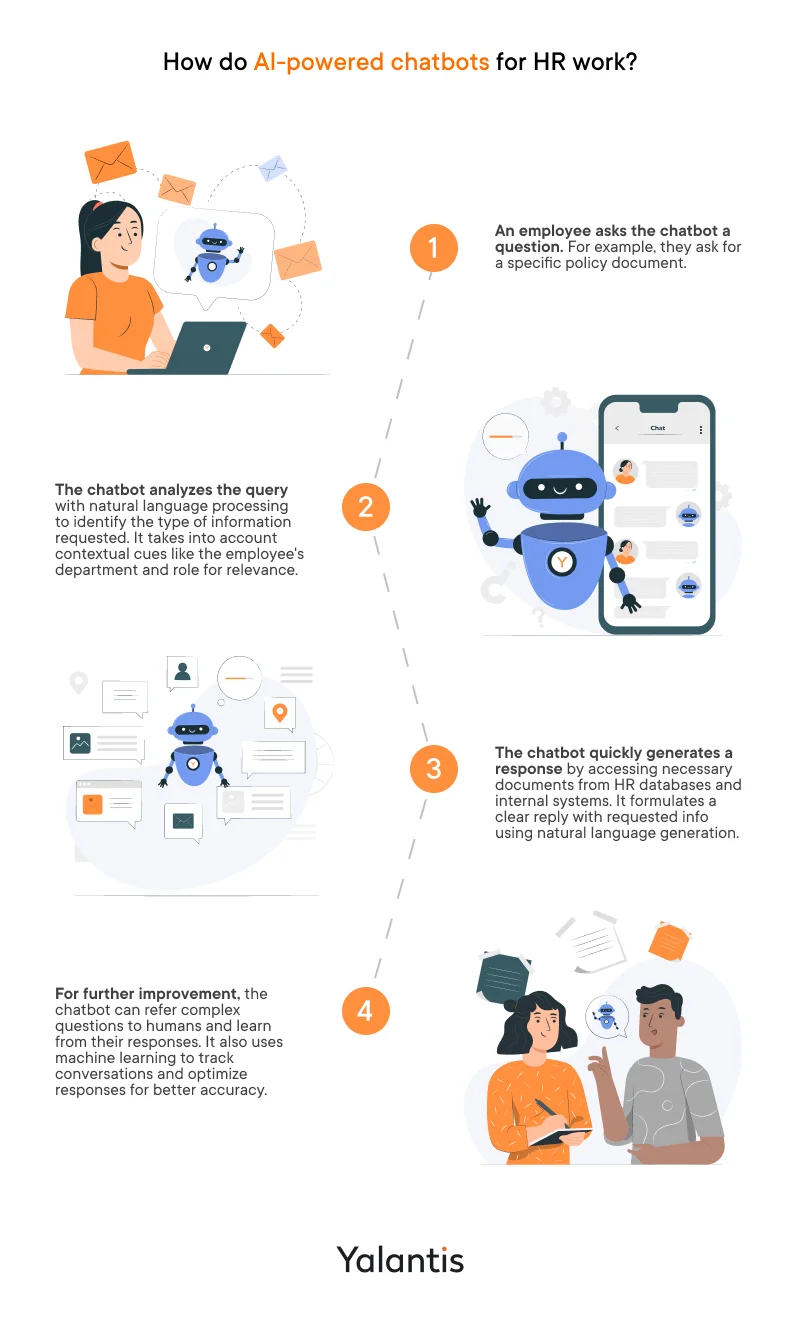
- An employee asks the chatbot a question. For example, they ask for a specific policy document on Slack or Microsoft Teams.
- The chatbot processes the query:
- An NLP algorithm analyzes the text to determine meaning and intent.
- Intent handling maps the query to predefined intents — types of questions/queries the chatbot is trained to recognize and handle. In our example, the chatbot recognizes that this is an information request for an HR policy.
- Contextual understanding uses details like the employee’s department and role to determine the policies applicable to them.
- The chatbot generates a response:
- The chatbot’s integration to HR databases and internal systems lets it rapidly retrieve the required document.
- Natural language generation formulates a clear response based on the document.
- Continuous improvement:
- The chatbot can hand off complex questions to human agents and then use their responses to enhance its knowledge.
- Machine learning lets the chatbot track conversations and metrics to continuously optimize its responses.
HR chatbots serve as a central knowledge repository, tapping into internal systems and leveraging AI/ML techniques to generate relevant human-like responses. Now, let’s visualize software components of chatbots to better understand how they interconnect for effective performance.
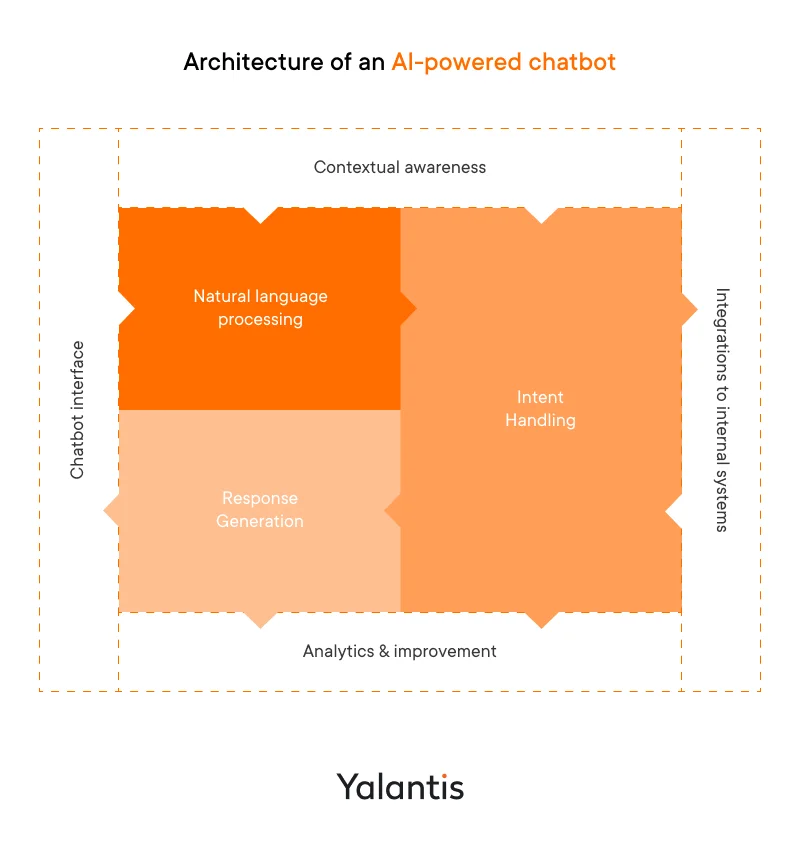
This architecture, consisting of integrations with internal systems, advanced data processing, and ongoing learning, forms a robust chatbot framework. The framework facilitates automation and streamlining of diverse HR tasks and can go beyond basic functions like finding policies. That’s why the growing appeal of AI chatbots to businesses, which we cover in the next section, is no surprise.
Reasons behind active adoption of HR chatbots and business benefits
While AI adoption in HR has been gradual, the rise of generative AI applications like chatbots is speeding up this trend. Experts anticipate a significant uptick in HR’s engagement with generative AI development due to the efficiency and valuable insights AI-powered chatbots bring to HR functions.
Moreover, AI chatbots can effectively address various HR-related issues, such as:
- Inability to efficiently work with vast amounts of data that is hard and time-consuming to locate and process manually
- Rigid onboarding processes that cannot be adapted to different roles or skill levels
- Scattered training resources that are spread across disconnected systems
- Weak employee progress monitoring, delaying gap identification and improvements
- Low retention rates due to factors like limited training and development
- Lack of visibility to senior leadership about HR service delivery metrics
These issues, if left unattended, can result in decreased employee knowledge, lower operational efficiency, and subsequently impact overall business outcomes. AI chatbots offer an efficient solution to these problems by delivering significant business benefits.
Key HR chatbot benefits: Internal operations and external brand and culture impact
AI-powered chatbots in HR impact both the internal operations of a company and its outward-facing brand and company culture. Long-term advantages include:
- improved operational efficiency due to optimal use of resources, such as time and staff
- stronger employer brand reputation in the marketplace due to better employee experiences and greater engagement
Businesses can get these benefits by:
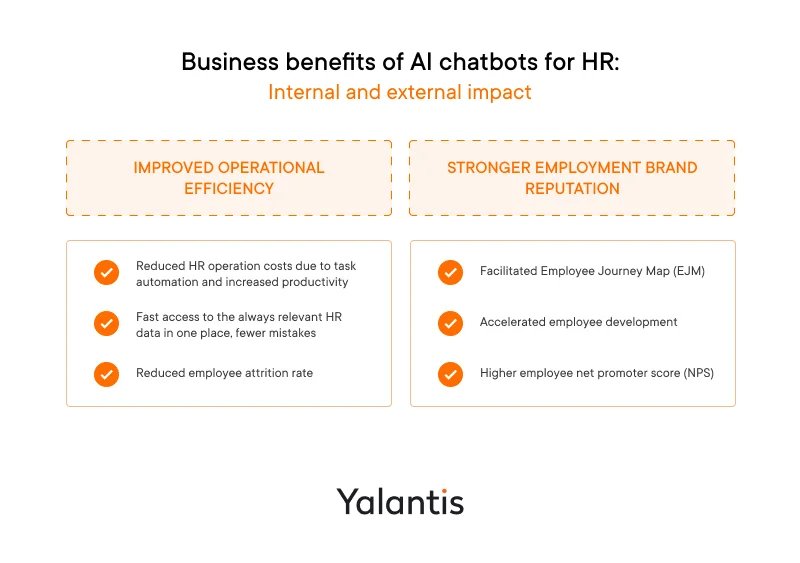
- Reducing HR operating costs via automation of routine tasks, boosting employee productivity, and getting data-driven insights into employee engagement.
- Easily accessing HR data in one place, reducing manual errors and ensuring quick access to accurate information, which simplifies compliance.
- Lowering employee attrition rates by providing convenient access to the company’s knowledge base, simplifying completion of tasks and resolving common queries.
- Guiding employees through critical journeys like onboarding, training, and development. HR chatbots improve employee experience and satisfaction scores by quickly answering employee queries and providing helpful content.
- Speeding up employee skills development by identifying skills gaps, suggesting relevant learning opportunities, and providing micro-learning. AI assistants integrated with learning management systems can also track certification renewals and remind employees to complete necessary training.
- Increasing the employee net promoter score by improving employee experience and engagement. Happier employees are more likely to recommend the company and serve as brand ambassadors.
In the following section, we provide some real-life chatbot HR use cases, which show how companies across industries already leverage the above benefits.
Top HR chatbot use cases for better business productivity and cost savings: Real-life examples across industries
According to 2023 estimates by Boston Consulting Group, a well-integrated human-generative AI strategy might increase HR productivity by up to 30% in the near term. Let’s explore the HR areas where generative AI-powered chatbots can significantly enhance productivity:
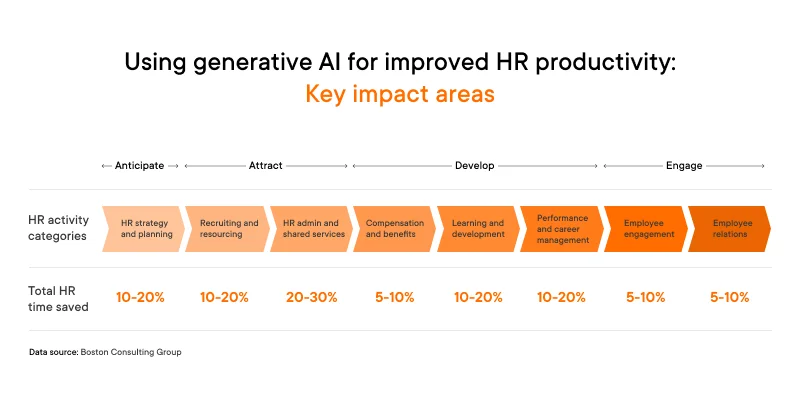
These potential productivity gains largely stem from chatbots saving resources such as human effort, time, and money. Read along as we showcase specific uses of HR chatbots throughout the employee lifecycle that drive improvements in particular HR areas.
Data-driven recruiting and hiring

AI chatbots interact with job candidates by posing questions, presenting assessments, and collecting feedback during the screening and recruitment process. The chatbot then analyzes these structured and unstructured interactions to reveal meaningful trends across applicants.
Examples of potential insights include:
- Identifying common qualities among current top performers based on responses during the hiring process. This enables benchmark comparisons with candidates.
- Detecting frequent knowledge gaps in certain domains. Findings can improve hiring criteria and shape training programs.
- Building candidate personality profiles based on chatbot conversations to evaluate cultural fit.
- Analyzing applicant sentiment across interview stages to uncover roadblocks. This can highlight areas to refine screening practices and better retain qualified talent.
Real-life case:
Indigo Books & Music, a major Canadian bookstore chain, has automated tasks like interview scheduling and candidate communication and quickly identifies qualified candidates by rediscovering past applicants.
Business benefits:
- Increased number of qualified candidates
- Reduced screening costs
- Decreased cost per hire
Consistent and sufficient onboarding supported with measurable performance data

By offering personalized guidance based on employee profiles, AI chatbots can enhance onboarding experiences and help new employees get up to speed quickly and feel more engaged in their roles. Here’s how HR chatbots can contribute:
- Addressing queries about company policies, benefits, and procedures
- Offering tips for success in the new role
- Monitoring new hires’ progress and identifying areas where they require additional support
- Providing checklists and reminders about required training and documentation
- Answering basic IT questions about systems access, equipment, and passwords
- Suggesting networking opportunities within the organization
- Creating reports for HR specialists with employee onboarding data like training completion rates or query types
Moreover, data collected from employee interactions by HR chatbots helps refine the employee onboarding process, ensuring the success of all new hires.
Real-life case:
SouthState Bank in the US trained a group of summer interns on how to use their corporate ChatGPT to quickly become experts at deposits or regulation.
Business benefits:
- Faster resolution of employees’ questions
- Increased new hire productivity
- Better employee compliance and fewer organizational risks
- Scalable and resource-efficient onboarding of large numbers of hires across multiple locations
AI-powered banking chatbots: Why it’s high time to embrace this solution
Read the articlePersonalized learning paths and progress tracking to optimize learning and development

The following are some of the ways AI chatbots help optimize employee learning and development.
- Analyzing training needs through conversational quizzes, which includes:
- Assessing employees’ knowledge
- Giving instant feedback on performance
- Prescribing targeted learning content to address knowledge gaps
- Building personalized learning paths aligned to roles, goals, and competency models, allowing for:
- Assigning training aligned to predefined development frameworks for each job type
- Setting reminders for certification renewals and milestones while tracking progress
- Recommending preparation courses
- Enabling managers to identify knowledge gaps and prioritize development programs by:
- Generating workforce training analytics, uncovering skills deficiencies by department, geography, or function
- Helping managers spot trends and expand development initiatives accordingly
Real-life case:
Infosys, an IT consulting company, employs an AI-powered learning experience platform where AI assistant Zoiee helps employees by taking notes, aiding in content creation, answering queries, and assessing learning progress.
Business benefits:
- Accelerated employee skill development
- Reduced compliance risk
- Enhanced productivity and performance
- Data-driven decisions for development investments
- Optimized training content and delivery
Self-service to automate the workflow and boost employee engagement

In a fast-evolving business landscape, an agile workforce requires instant access to vital information. Once integrated with HR systems, chatbots can fulfill this need, either supplementing or replacing traditional employee portals.
- The standard HR portal transforms into an interactive advisor, offering answers, guiding users, and facilitating requests like paycheck access or personal information updates.
- Daily interactions with HR chatbots deliver bite-sized learning modules, providing immediate assistance on processes or systems during work.
- Compared to videos or webinars, a bot actively engages users, simplifying information retrieval without the need to directly contact HR, search extensively across company information spaces, or navigate online content.
Over time, the responsive bot can become the primary resource for employee queries.
Real-life case:
ABN AMRO bank employs Abby, an AI virtual assistant supporting global HR teams. At the 2023 DXB Europe Summit in Amsterdam, attended by our Yalantis team, ABN AMRO presented impressive results: they reduced the employee attrition rate from 60% to 20% over half a year due to increased employee engagement. To enhance the AI assistant’s capabilities further, they run ChatGPT-like trials, exploring summarizing knowledge articles, among other features.
Business benefits:
- Automation of HR administrative tasks
- Enhanced employee satisfaction and experience
- Reduction in employee attrition, leading to cost savings
Performance management to boost employee experience and competency

Last but not least, AI chatbots offer immediate insights to managers by analyzing employee–chatbot interactions and company data. This approach can improve the employee experience and optimize individual or team performance by:
- automating goal setting, check-ins, reviews, and feedback for both employees and managers
- identifying process inefficiencies by analyzing performance trends
- spotting competency gaps to enhance training and hiring efforts
- monitoring employee sentiment through conversations to gauge engagement
- detecting signs of burnout like declining productivity and prescribing assistance
Real-life case:
AVIA, an AI-powered companion of software company Icertis, helps conduct conversational surveys, track employee feedback and queries, and assess team performance. Chatbot analytics reveal insights into HR executives’ ratings, response times, and query resolution, pinpointing areas for improvement.
Business benefits:
- Improved employee engagement via streamlined reviews and feedback processes
- Cultivation of expertise through a culture of continuous improvement
- Heightened productivity by automating administrative tasks
- Informed HR resourcing decisions guided by data insights
Now that we’ve covered the most effective HR chatbot applications, let’s do a quick recap. Here’s a summary of key HR chatbot use cases and their associated business benefits:
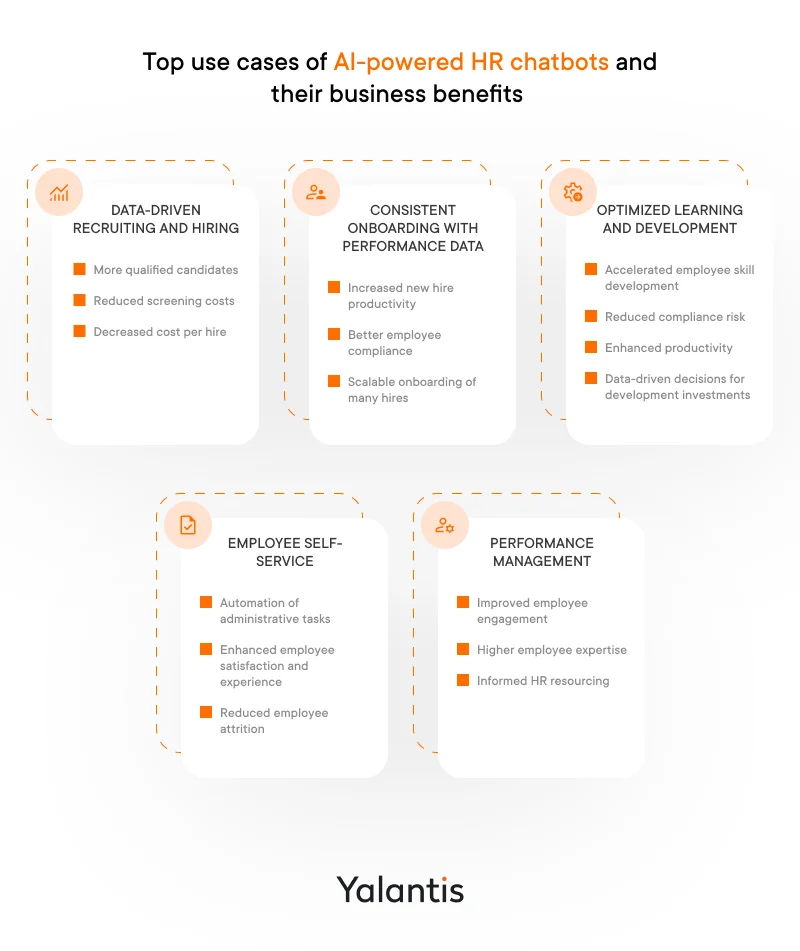
Want a more detailed look at how different industries use AI chatbots for their HR operations? The following download is for you.
Discover how various industries use AI chatbots for HR: Comparison table from Yalantis
Download tableIf any AI-powered chatbot use cases match your business needs, it might be time to think about using HR chatbot development services. In the following sections, we present options for you to consider. We compare off-the-shelf versus customized solutions to help you find a provider that suits your business requirements.
Overview of chatbots for HR: Ready-to-use solutions for a quick but limited implementation
Given the many benefits of AI-powered solutions for HR operations, it’s not surprising that the AI chatbot market provides a wide array of options. Having analyzed many of them, we are ready to present the top three AI-powered chatbot solutions for HR.
Note, however, that such solutions often come with limitations, which we’ll address later on.
Capacity
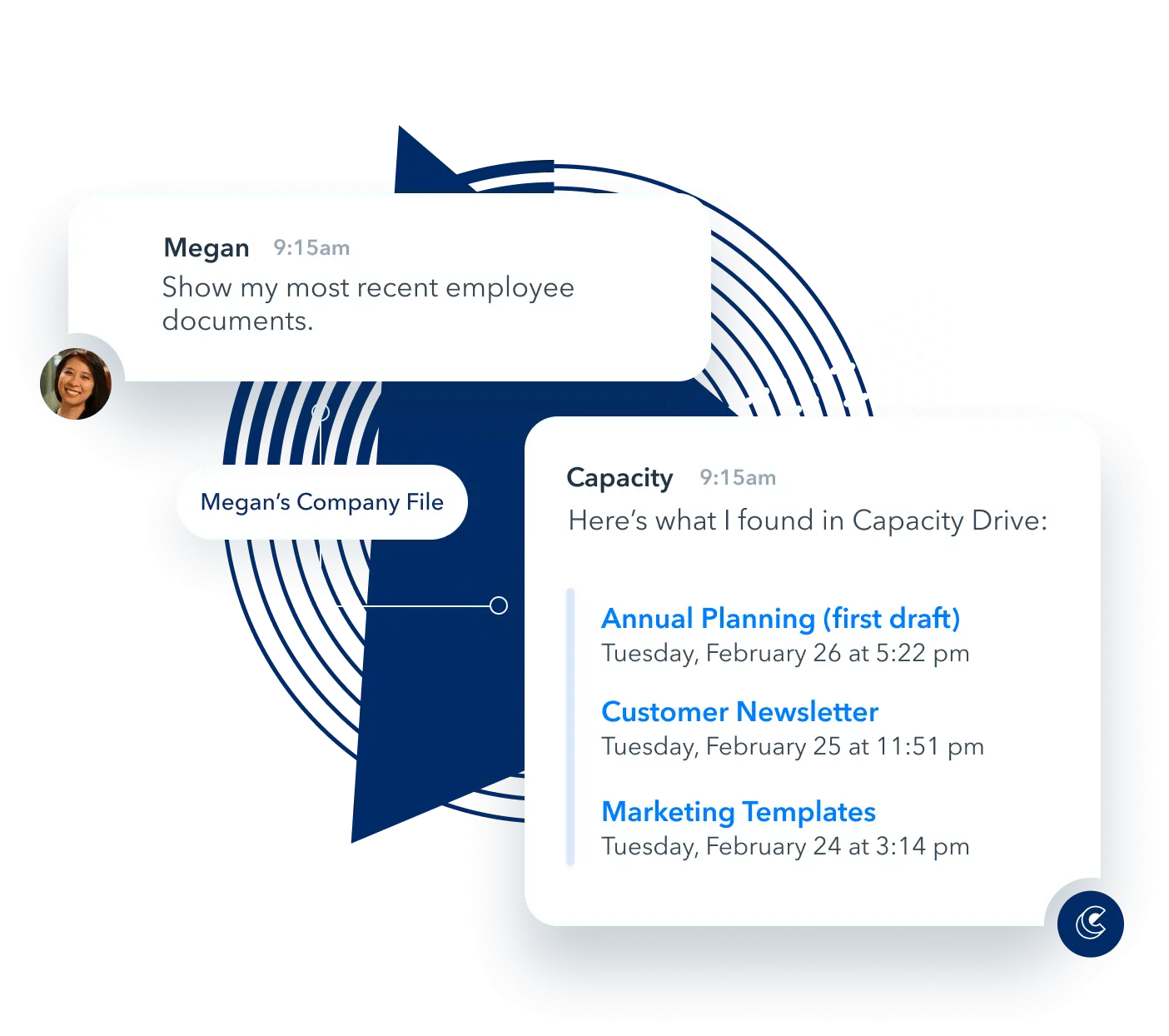
Capacity is an AI-native knowledge-sharing platform offering automated support for customers and employees. If it lacks an answer, it seamlessly sends the question to the right subject matter expert through a ticket or live chat. Key features of Capacity include:
- Developer platform for embedding Capacity into existing chat interfaces
- 150+ platform integrations
- Human-in-the-loop CoPilot Console
- AI-assisted knowledge base
- Enterprise user permissions (group, geolocation, department, etc.)
- Guided conversations with lead generation capabilities
- Company-wide broadcasts and notifications
- GDPR, CCPA, and SOC 2 compliance
Leena.AI

Leena AI is an AI-driven conversational platform that automatically addresses employee queries, streamlines daily HR operations, and resolves employee tickets. By integrating with existing human resources information systems, it consolidates the entire HR helpdesk into a single interface.
- Proprietary large language model — WorkLMTM
- Knowledge and document management
- Organization-wide announcements
- Omnichannel experience
- Analytical reports for senior management
- Multilingual support
- Multi-platform integrations
- GDPR compliance
Workativ Assistant

Workativ is a no-code platform enabling companies to swiftly create, automate, and deploy conversational AI chatbots integrated with app workflow automation. It primarily targets employee IT and HR support in digital and hybrid workplaces, automating inquiries and requests.
Among its key features are:
- Pre-built app workflow automations for popular HR and payroll apps
- Deployable on Slack, Microsoft Teams, or as a chat widget
- Live transfers to HR teams
- Analytics and logs for reviewing chatbot usage, sessions, queries, and live status
- Automated approval management for employee requests
- Dynamic notifications
- AES 256-bit encryption for data protection
Workativ and similar off-the-shelf HR chatbots offer a strong foundation for automating key HR processes, delivering quicker and more cost-effective implementation than custom solutions. However, these solutions might not address all of a business’s complex needs.
Limitations of ready-to-use AI chatbots for HR
Implementing ready-made HR chatbots is faster than creating custom solutions, but it’s essential to consider the following factors:
- Limited customization and control. Off-the-shelf options provide instant usability but might lack required functionality. Besides, they restrict you to the vendor’s roadmap, which makes it challenging to adjust the chatbot to meet evolving business demands, calling for additional resources and slowing down operational effectiveness.
- Data privacy and security risks. Relying on external chatbot vendors that host data in separate clouds outside the company’s own IT environment may introduce cybersecurity and data protection concerns around sensitive data. If data isn’t properly encrypted and secured, there may be potential entry points for breaches.
- Additional training. A company might also need to allocate resources for organizing workshops to onboard employees and ensure the smooth adoption of a chatbot. This can be particularly inefficient for larger companies due to complex organizational structures and distinct customization needs for different departments and regions.
While you can switch to another vendor, doing so can affect operational efficiency due to the time and effort spent integrating with another solution. Besides, merely using AI chatbots isn’t enough — future-proofing your business to meet evolving AI trends is key. That’s where custom HR chatbots prove most useful.
If you do decide to go with a ready-made HR chatbot solution, remember that it’s not just about purchasing or subscribing. You’ll still need to prepare for integration, which demands extra time and resources:
- Migrating data
- Setting up backups
- Taking security and data privacy measures
To save time and speed up the process, consider consulting services from Yalantis (machine learning consulting company). With extensive AI/ML experience, we can help integrate an AI solution securely and reduce the time to market. This way, your team can start making the most of an off-the-shelf chatbot.
Need professional support?
Yalantis will design your AI implementation roadmap and help you implement the solution.
Explore AI consulting servicesHowever, if you’re looking for a tailored AI chatbot experience, here’s why a custom chatbot for internal employees is your best bet.
Custom HR chatbot for employee engagement, operational efficiency, and more
A custom employee engagement bot delivers a personalized, secure, intelligent, and evolving conversational experience to end-users by targeting the company’s distinct needs, data, and preferences.
The most effective way to create an HR chatbot is to fine-tune an existing generative AI model like Open AI’s GPT. This way, your AI chatbot is optimized to your organization’s needs and use cases. Here are some key things to know about this process:
- The AI model is fine-tuned or exclusively trained using your company’s own data and industry knowledge, including past conversations, documents, and more to enhance accuracy.
- You can define the exact scenarios, workflows, integrations, and conversations you want the HR chatbot to handle.
- The persona, tone, and language can easily be customized to perfectly represent your brand voice.
- Ongoing maintenance, updates, and improvements to the bot can focus on your specific business requirements.
Undoubtedly, custom development entails higher upfront investment and longer implementation time (though as we’ll see later, there are solutions to accelerate this). But for many companies, full control, robust security, and other benefits outweigh the costs:

- Full control over customization of the chatbot’s capabilities, conversation flows, integrations, and features to meet specific business needs
- Higher data accuracy due to fine-tuning on company data that trains the model to understand industry terminology and company specifics
- Robust security that ensures the HR chatbot is built to meet all security and compliance standards within the industry
- Scalability that allows for hassle-free improvements to continually enhance the chatbot based on evolving business needs
While custom development is beneficial, challenges like talent shortages or a lack of AI expertise may discourage companies from pursuing in-house development. However, this doesn’t mean they can’t enhance their HR operations with a tailored AI chatbot. Outsourcing to a company experienced in the field could be the solution.
To sidestep the complexities of in-house development and lower costs, consider Yalantis’ AI chatbot solution, which we can customize to work for any use case your business requires. We offer a range of AI-driven HR assistant solutions designed to streamline HR operations and enhance employee experience.
How an AI-powered HR chatbot from Yalantis can reduce implementation costs and optimize HR operations
Designed to meet both simple and complex business needs, a customizable AI bot for internal HR use across departments from Yalantis can:
- Reduce your development and implementation costs
- Accelerate your time to market
- Incorporate essential security measures
- Integrate seamlessly with your technology solutions
- Be tailored to your business’s data
Leveraging generative AI expertise and robust cybersecurity knowledge, Yalantis can provide your business with an Employer’s Digital Assistant — an AI-powered virtual assistant similar to ChatGPT in operation. Our solution not only refines chatbot technology but also lays the groundwork for future complex use cases.
Key functionalities of our Employer’s Digital Assistant include:
- Data parsing and storage. Our bot structures and stores information extracted from documents in a searchable database using natural language processing.
- Robust AI model. Operating on the Hugging Face AI model, which works similarly to ChatGPT, the chatbot provides relevant responses based on data it can access and provides links when necessary.
- User-friendly interface. Employees can interact seamlessly with the bot via a web app supporting text- and voice-based queries.
- Tailored features supporting the employee journey, from personalized onboarding plans that track ongoing progress to managing employees’ learning curves.
- Stringent data privacy and security measures. Prior to development, we evaluate your data’s sensitivity and create comprehensive security solutions — for example, a privacy-by-design approach and encryption of data both at rest and in transit.
We understand the challenges of navigating the complex AI landscape. That’s why we provide comprehensive support at every stage of your generative AI journey, from defining business problems to fine-tuning the HR chatbot to meet evolving business needs and onboarding business users.
Interested in further exploring this technology? See what your business can get with our solution.
Get the most out of an AI chatbot for your HR operations.
Discover an AI-powered digital assistant from Yalantis.
Explore AI chatbotFAQ
Should my business partner with an IT infrastructure company for our chatbot project?
Yes, partnering with an IT infrastructure company can provide the necessary backend support and integrations to implement an AI chatbot. Your partner can set up servers and databases, implement security measures, and make connections to internal systems. In this case, it’s crucial to team up with a software company with extensive generative AI experience.
What technology infrastructure services does my business need to implement a chatbot?
Key services needed include cloud hosting, database configuration, API and integration development, identity and access management, cybersecurity protections, and monitoring/support for infrastructure uptime and performance. To efficiently assess and implement the required services, consider partnering with an expert IT infrastructure company.
How can an IT infrastructure consulting services provider help in implementing an AI chatbot?
They can advise on infrastructure architecture, ensure smooth integrations with existing systems, implement robust data pipelines and security, provide ongoing management/monitoring, and scale capacity as chatbot usage grows. The expertise of such providers facilitates AI chatbot deployment.
Rate this article
4.6/5.0
based on 83 reviews



